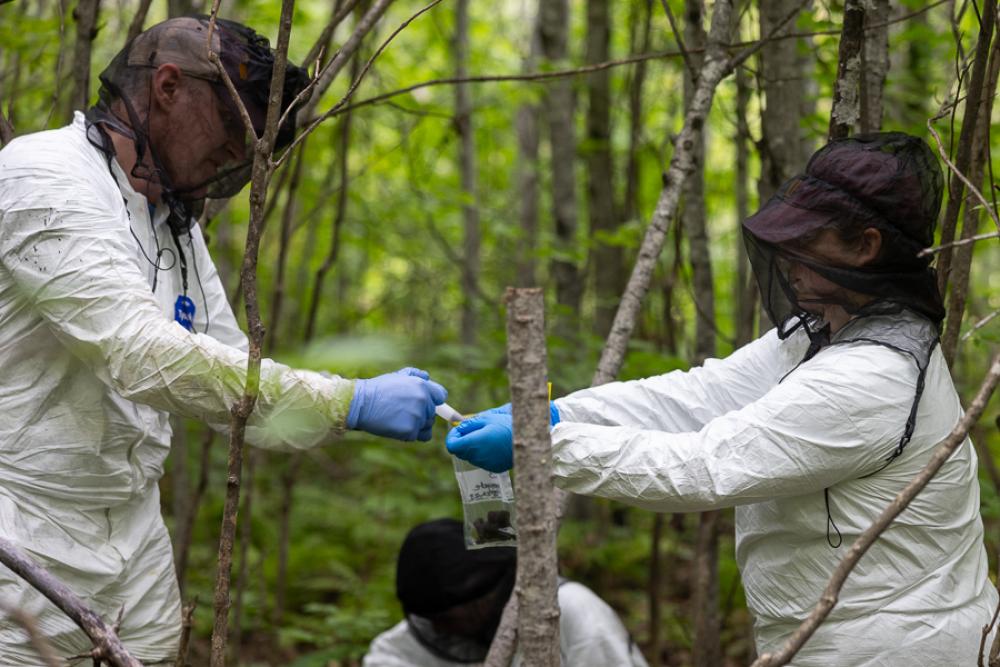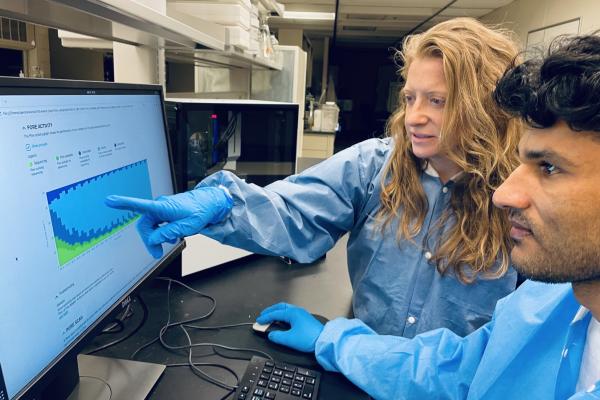Cracking the CWD case: Researchers use forensic techniques to investigate an illegal deer dump
June 6, 2024

Research team members Dr. Peter Larsen and Corina Valencia Tibbits bag samples from the site. Photo courtesy of Thomas and Tonya Seiler, MNPRO.
Researchers from the Minnesota Center for Prion Research and Outreach (MNPRO) at the University of Minnesota College of Veterinary Medicine developed a new approach to veterinary forensic investigations that can serve as an important tool for the management of chronic wasting disease (CWD) and other related diseases.
Forensic investigations have been unraveling mysteries surrounding human remains since the 19th century, and thanks to technological advancements, they can now address biological and legal questions with exceptional accuracy and precision. But animal-focused forensic investigations have lagged behind their human counterparts in the adoption of advanced technologies for veterinary forensics, despite their utility in cases of animal abuse, illegal animal trade and hunting, disease outbreaks, and more.
One scenario where such investigations have significant potential is in the management of CWD, a highly contagious, 100% fatal neurodegenerative disease affecting deer, elk, moose, and other cervids. The disease has spread rapidly in Canada, the United States, South Korea, and Nordic countries. Because the prions—or misfolded proteins—that cause the disease persist in the environment and remain infectious over years, regulations restricting carcass movement and disposal have been enacted in states across the country.
In cases where those regulations are violated, veterinary forensics offers a crucial additional tool for CWD management.
This study, led by researcher Marc Schwabenlander, focused on an illegal deer carcass dump site of a CWD-positive captive deer facility that was discovered by state and federal regulators. The team used an interdisciplinary forensic approach, which they termed prion forensics, to analyze specimens from both the dump site and the facility. They anatomically assessed the specimens and estimated the age of the animals at time of death.
Despite the decomposition of the remains, they were able to determine that at least six illegally dumped carcasses were CWD-positive using a technique called real-time quaking-induced conversion (RT-QuIC) that was developed for the detection of multiple prion diseases. Furthermore, through genetic testing, they were able to link the deer remains to the herd from the facility.
As CWD continues to spread geographically, illegal or irresponsible disposal of carcass materials creates opportunities for environmental contamination and indirect (environment to animal) disease transmission.
It appears that such contamination likely resulted from the investigated dump site, given the detection of CWD prions among the carcass materials recovered from the site. The investigation indicated that remains had been scavenged and spread, and previous research indicates that scavengers such as crows and coyotes can potentially spread prions. In fact, within a year of the site’s discovery, according to the team’s dating of the remains, two wild white-tailed deer tested CWD-positive approximately 65 km south of the site and more than 100 km from any other known CWD-positive source. Although the deer cannot be definitely linked to the dump site, this was the first case of CWD in the area.
“Human activities have been hypothesized to be the source of the geographic spread of CWD to locations that cannot be easily explained by natural cervid movement,” Schwabenlander described. “Our study may be the first to provide evidence that improper carcass handling may contribute to CWD spread.”
The methods and findings of the study are not only useful in characterizing past events, but also to inform future research aimed at better understanding ecological interactions, predicting risk for future outbreaks, and developing new control and mitigation strategies. The MNPRO team continues to lead research at the site, exploring the extent of prion contamination in soils and water samples from the local environment where deer carcasses were found.
The research was funded by the Legislative-Citizen Commission on Minnesota Resources (LCCMR), stewards of the Minnesota Environment and Natural Resources Trust Fund (ENRTF).
Read the full study in Prion.


